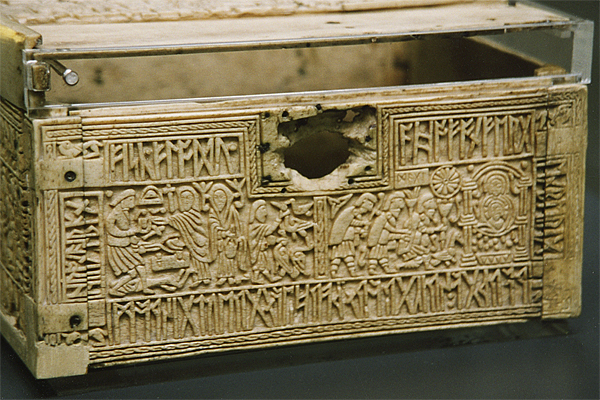
Return to the Early English Church

Quid Hinieldus cum Christo? ("What has Ingeld to do with Christ?")
Alcuin, Letter to the Bishop of Lindisfarne (AD 797)
Dating from the first half of the eighth century AD, about the same time that Beowulf may have been written down, the Franks Casket was carved in relief from whale bone (the runes on the front panel speak of a whale stranded on the shingle). A portion of the lid is missing, and end-panel on the right side of the casket has been detached and now is in the Museo Nazionale del Bargello in Florence (below). The other panels were purchased from a dealer in Paris and presented to the British Museum in 1867 by the collector whose name they bear. How the casket came from the north of England to Frankish Gaul is not known, but it may have been taken there in the middle of the tenth century and looted from a church during the French Revolution.
"Weland, by way of the trammels upon him, knew persecution. Single-minded man, he suffered miseries. He had as his companion sorrow and yearning, wintry-cold suffering..."
Deor
The front panel pictured depicts the Germanic legend of Weland the Smith and the Adoration of the Magi. Weland (Wayland), the Old English spelling of Volund, the semi-divine smith of Scandinavian lore, was well known to the Anglo-Saxons. A neolithic long barrow near Uffington was thought to have been his smithy, and the ancient corslet that Beowulf wears against Grendel, "the armour cunningly linked by the skill of the smith," to have been crafted by him. His most famous sword, Mimming, is mentioned in the fragment Waldhere as not failing the person who wields it. And King Alfred, in his translation of Boethius' Consolation of Philosophy, substituted the name of Weland, "the famous and wise goldsmith," for that of the Roman Fabricius, the conqueror of the Samnites, because it suggested the notion of "craftsman" (fabricator) and would have been recognized more readily by the reader.
The "Lay of Volund" (Volundarkvitha) is one of the oldest in the Poetic Edda, a collection of Norse mythology and heroic legend that survives in the Codex Regius, a unique Icelandic manuscript written about 1270. It relates the vengeful story of Volund, lord of the elves, unjustly held captive by King Nidud (Nithhad), who takes for himself the smith's magic sword and gives the gold ring he had wrought for his Valkyrie bride to his own daughter Bodvild (Beadohild). Hamstrung and imprisoned on an island, Volund is forced to work at the king's forge, making him all manner of wondrous things. But, when the king's young sons come to see his treasures, Volund kills the hapless boys and fashions drinking cups from their skulls and jewels from their eyes, which he sends to the unsuspecting king and queen. From their teeth, he makes a brooch for Bodvild. Later, when she comes to have the stolen ring repaired, she is enchanted and seduced. The lay ends with Volund eliciting an oath from the king that he will harm neither Volund's wife nor child. Rising in the air, he then laughingly reveals to the horrified king the source of the jewels and that he has murdered his sons and impregnated his daughter. So Volund takes his revenge.
In this detail from the front panel, Voland proffers the cup to Bodvild, who is accompanied by an attendant. She does not know that it has been fashioned from her brother's skull, whose body can be seen at the smith's feet. On the right, Weland's own brother catches birds to make the wings that they will use for their escape. The juxtaposition of murder and seduction with the birth of Christ may seem an odd iconography, and the intended parallel may be that the heroic Widia, the son born to Bodvild, also redeems sin and suffering.